The 13 Best Types Of Palm Trees To Plant In Arizona (Photos)
If you’re looking to add some tropical flair to your Arizona landscape, you’ve come to the right place. In this article, we’ll be exploring the top 13 types of palm trees that thrive in the Grand Canyon State. From majestic palms to compact and versatile options, there’s something for every taste and space. Whether you’re seeking a statement piece or a low-maintenance addition, read on to discover our expert recommendations.
Our list includes a diverse range of species, each with its unique characteristics and benefits. You’ll find palms that provide dappled shade, those that produce delicious fruit, and even those that can tolerate the hottest desert sun. And while some may be more finicky than others when it comes to care, we’ll also be sharing tips on how to keep your palm trees happy and healthy.
So go ahead, get ready to palm your way through Arizona’s sunny landscape!
Types of Palm Trees In Arizona
Alexandra palm (Archontophoenix alexandrae).

In Arizona, the Alexandra palm stands out as a crowd favorite. This rapid-growing palm can reach impressive heights of up to 30 feet, boasting vibrant green leaves with a stunning glossy finish. The sturdy trunk, adorned with light brown hues and darker brown stripes, adds a touch of elegance to any landscape. A native Australian species, the Alexandra palm is surprisingly adaptable and thrives in various climates.
For those seeking to inject a dash of tropical flair into their outdoor space or looking for a fast-growing palm solution, this versatile plant is an excellent choice.
Bismarck Palm (Bismarckia nobilis).
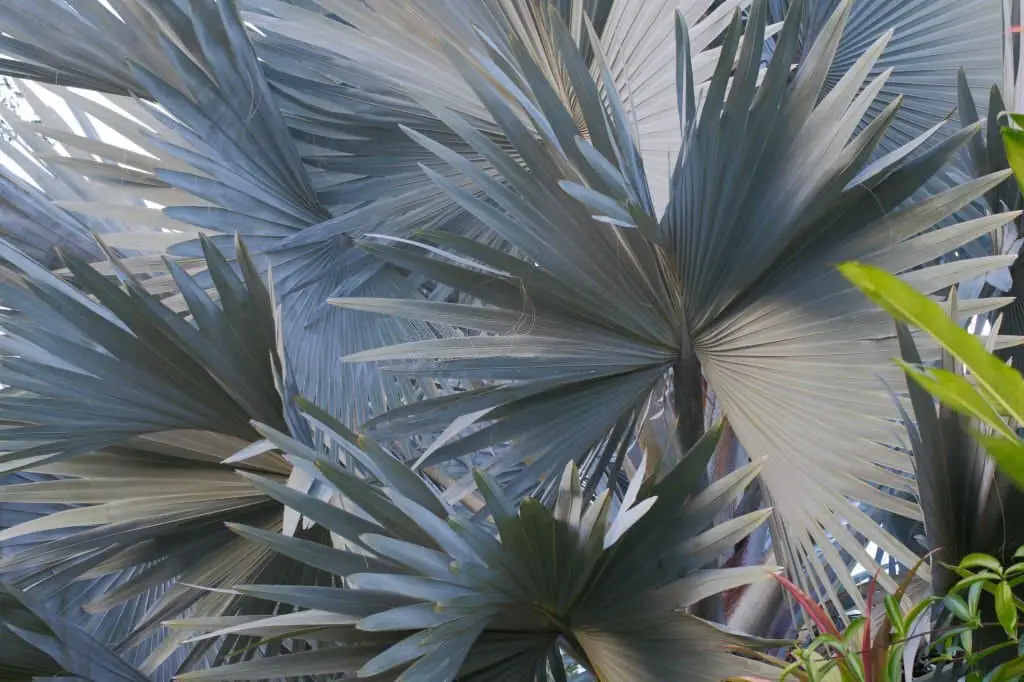
The Bismarck Palm, native to Madagascar, was introduced to Arizona in the early 1900s. This stunning tree can reach heights of up to 60 feet, with a robust trunk that spans up to 24 inches in diameter. Its distinctive leaves boast a striking blue-green hue and can extend up to 12 feet in length. In the spring, delicate white flowers bloom, accompanied by vibrant red fruit roughly the size of a grapefruit.
Arizona’s arid climate poses no challenge for this hardy palm, which not only tolerates drought but also requires minimal watering. If you’re seeking a palm tree that can thrive in the Grand Canyon State, the Bismarck Palm is an excellent option.
California fan palm (Washingtonia filifera).
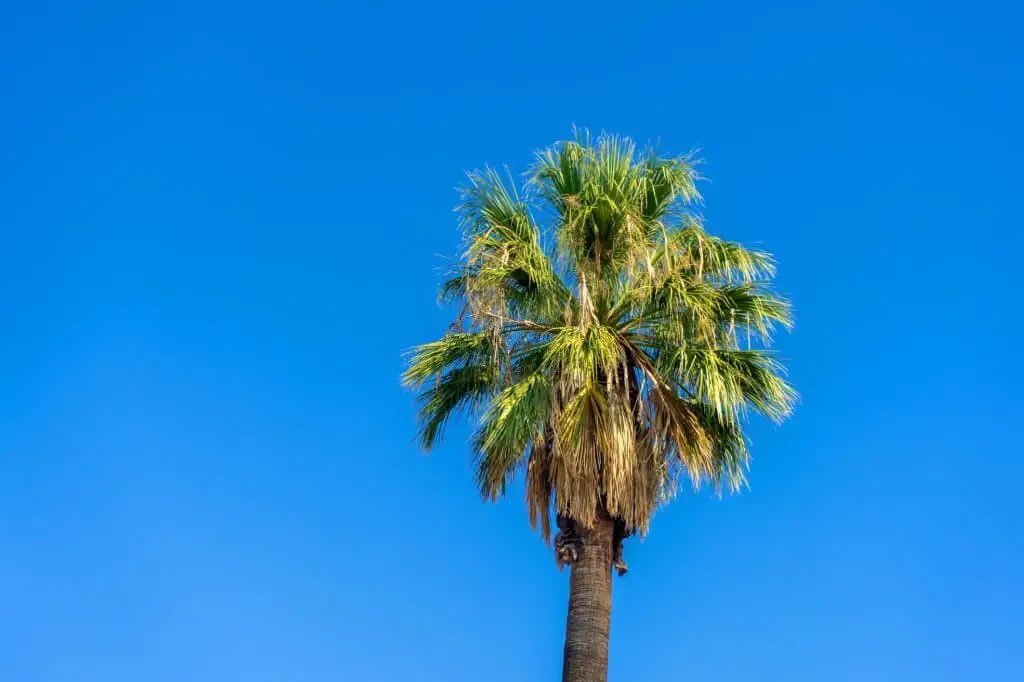
Native to the southwestern United States and northwestern Mexico, the California fan palm thrives in canyons, washes, and along streams. Historical records reveal that they were introduced into Florida during the 1800s and have since become naturalized there. The tree is also common in Arizona as well as other parts of the American Southwest and Mexico.
Characterized by its large evergreen stature, growing up to 20 meters (66 feet) tall with a sturdy trunk measuring up to 80 centimeters (31 inches) in diameter, covered in old leaf bases. Its palmate leaves reach lengths of about 90 centimeters (35 inches) and are comprised of numerous narrow leaflets.
The tree’s leaf stem measures between 0.75-15 centimeters (0.30-0.59 inches) long, culminating in a sharp point.
Small, white or pale yellow flowers are borne on clusters up to 20 centimeters (79 inches) long that dangle from the leaf axils.
The fruit is a black drupe measuring up to 15 millimeters (0.59 inches) in diameter; unfortunately, it is toxic to humans. The California fan palm typically inhabits desert washes and canyons at elevations ranging from sea level to approximately 1,500 meters (4,921 feet).
This hardy tree boasts exceptional drought tolerance, attributed to its deep root system that enables access to groundwater during arid periods.
Hybrid King Piru Palms (Syagrus romanzoffiana ‘piru’ x Butia Capitata ‘King’).
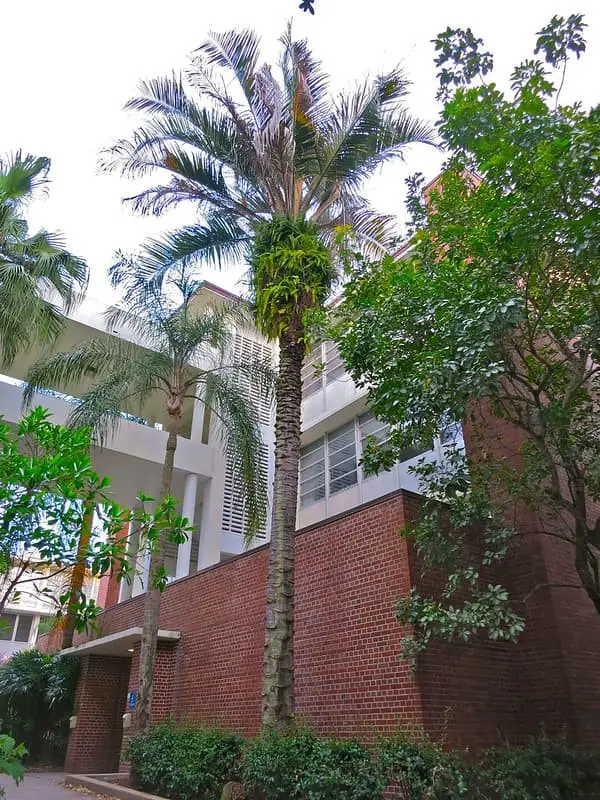
Arizona’s palms are often misunderstood, as they don’t conform to the typical image people have in mind when thinking about this state’s flora. In reality, these trees are a unique blend of two palm species: the King Palm and the Piru Palm. This hybrid has been cultivated to thrive in Arizona’s arid environment, while still retaining its tropical charm.
The result is a resilient and visually striking palm that defies expectations, offering a delightful surprise for those familiar with Arizona’s landscape.
Hybrid Mexican Fan Palms (Washingtonia hybrid).
Arizona’s desertscape is often characterized by the presence of palm trees, specifically a hybrid species resulting from crossing Washingtonia filifera (desert fan palm) with Washingtonia robusta (Mexican blue palm). This crossbreeding first took place in Southern California in the early 1900s, before being introduced to Arizona. As sterile hybrids, these palms cannot reproduce through seeds and instead must be propagated via rooting cuttings.
Notably, they grow rapidly, reaching heights of up to 60 feet (18 m) within a few years. The leaves display a distinct blue-green hue with a leathery texture, featuring finely serrated margins and V-shaped leaflets. Small white flowers appear on lengthy panicles that dangle from the leaf axils. Inedible fruit takes the form of small black drupes.
These palms exhibit remarkable adaptability, thriving in a wide range of soil conditions, including poor sandy soils, and showing resilience to extended droughts without water. As a result, they are extensively used for landscape plantings throughout Arizona, as well as being popular choices for houseplants.
Mediterranean Fan Palms (Chamaerops humilis).
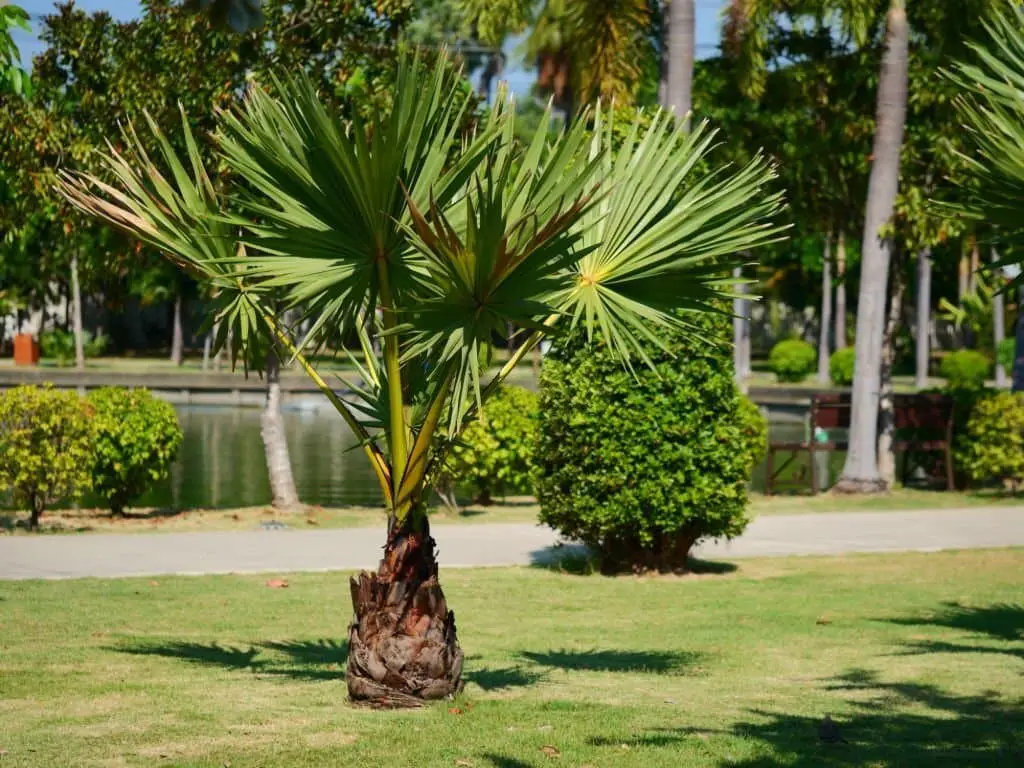
According to the University of Arizona Cooperative Extension, the Mediterranean Fan Palm is renowned for its remarkable cold hardiness among true palms. Not only do they exhibit resilience against drought, but they can also thrive in a broad spectrum of soils provided it’s well-drained. With optimal care, these palms have the potential to live for decades.
Characterized by their large and numerous fronds featuring a silvery-green hue, Mediterranean Fan Palms typically grow up to 20 feet in height, although some may remain shorter. As a popular landscape choice in Arizona, they are often utilized to add aesthetic value to outdoor spaces.
Mexican blue palm (Brahea armata).

The Mexican blue palm, a stunning specimen, can reach heights of around 50 feet. Its native habitat spans across Mexico and Arizona, making it an ideal choice for landscaping in the southwestern United States. This resilient palm thrives in full sun and well-drained soil conditions, withstanding both heat and drought with ease. Notably, it can tolerate temperatures as low as 20 degrees Fahrenheit, a testament to its cold hardiness.
While growth may be slow-paced, the Mexican blue palm’s unique beauty makes it well worth the wait.
Pindo Palms (Butia capitate).

In South America, there’s a type of palm tree that’s not only native but also renowned for its delectable fruit. Known as the Pindo Palm, it’s often referred to as the Jelly Palm or Wine Palm due to its edible bounty. This resilient species can thrive in chilly temperatures, with some specimens having survived temperatures as low as -15 degrees Fahrenheit.
The Pindo Palm has gained popularity in many US regions, including Arizona, where its hardiness and unique features make it a sought-after landscaping choice.
The Pindo Palm is a slow-growing palm that can reach an impressive 20 feet tall. Its solitary trunk is adorned with long, narrow leaves that can stretch up to 12 feet in length, showcasing a palette of green, blue-green, or silver-gray hues. In the spring, it produces vibrant yellow or orange flowers.
The fruit itself is a drupe, roughly the size of a fig, featuring a sweet and edible pulp surrounding a large seed.
The Pindo Palm’s fruit has been used to create jams, jellies, and wine, further solidifying its reputation as a versatile and flavorful palm tree. Its remarkable adaptability to cold temperatures, combined with its striking appearance and culinary uses, make the Pindo Palm a beloved choice for many gardeners.
Pineapple Palms (Phoenix canariensis).
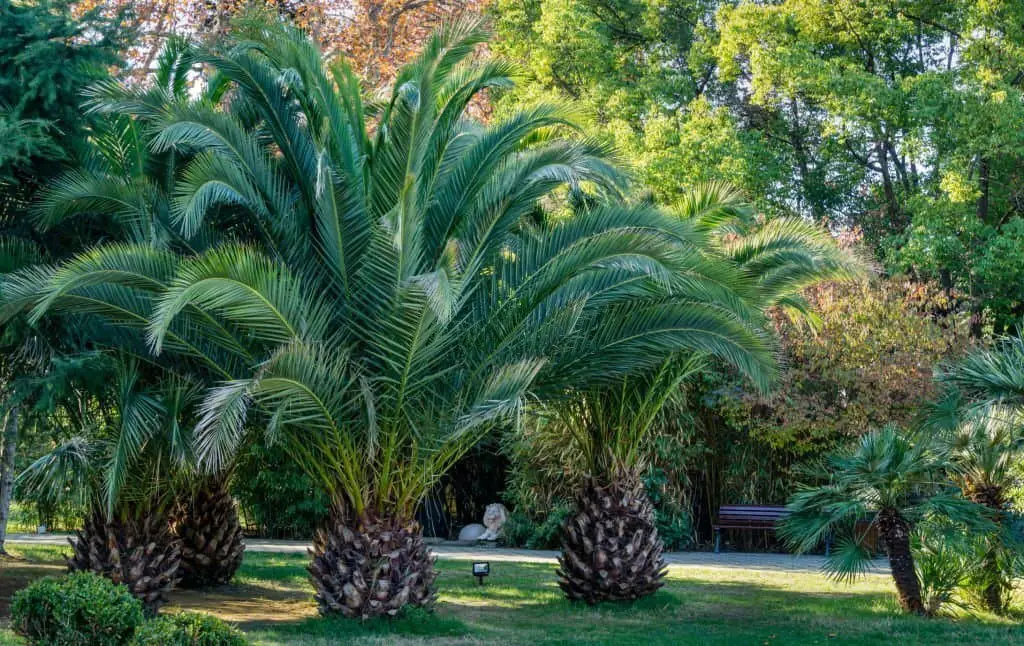
In the southwestern United States, particularly in Arizona, the Canary Island Date Palm (Phoenix canariensis) has become a staple of landscaping due to its unique characteristics and adaptability. As its name suggests, this palm species hails from the Canary Islands, with Tenerife being the specific island that lent its scientific name.
Reaching heights of up to 50 feet and boasting a lifespan of over 100 years, this majestic palm tree is readily identifiable by its striking blue-green leaves and vibrant yellow fruits.
While it’s a slow-growing species, the Canary Island Date Palm can still make significant gains in just 15 years, reaching heights of around 20 feet. Its remarkable resilience allows it to thrive in arid environments, tolerating drought conditions and even temperatures as low as 20 degrees Fahrenheit.
As an evergreen tree, this palm species retains its leaves year-round, providing a constant aesthetic appeal. Moreover, the Phoenix canariensis has earned recognition for its remarkable ability to filter pollutants from the air, making it an excellent choice for urban environments.
Piru Queen Palms (Syagrus romanzoffiana ‘piru’).
The Piru Queen Palm is an impressive sight to behold, with its slender trunk reaching heights of over 50 feet. Native to Brazil, this fast-growing palm has been successfully introduced to various regions, including Arizona, where it thrives in the desert landscape. Its popularity stems from its remarkable adaptability and rapid growth rate, making it a top choice for streets and large-scale landscaping projects.
Characterized by its single, dark green trunk adorned with palmate leaves that can span up to three feet wide, this palm is truly a striking specimen. The leaflets are edged with sharp spines, adding an air of rustic charm to the overall aesthetic.
In the spring, the Piru Queen Palm bursts forth with bright yellow flowers, which give way to small, round fruits that turn a deep red hue as they ripen.
This palm’s relatively low-maintenance requirements mean it can thrive with minimal care once established. Its drought tolerance and ability to withstand occasional freezing temperatures make it an attractive option for gardeners and landscapers alike.
Pygmy Date Palms (Phoenix roebelenii).
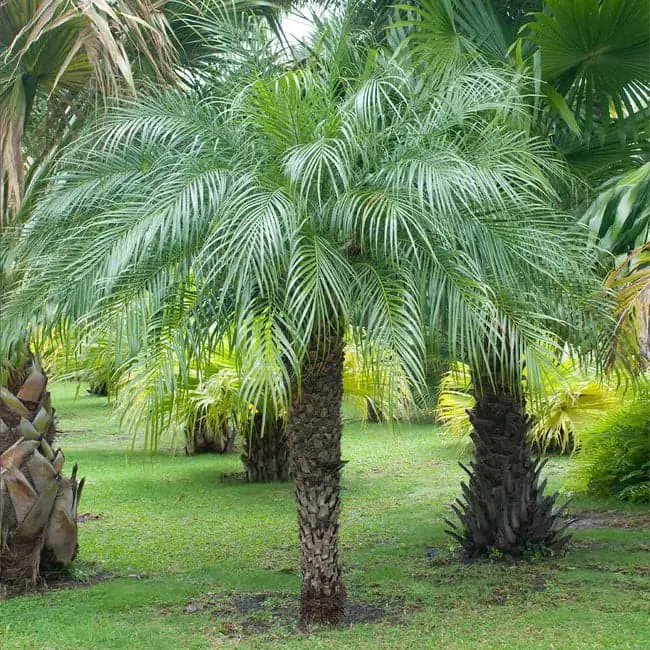
In many parts of the world, including southeast Asia where they’re native, Pygmy Date Palms are a common sight as houseplants or office decor. Characterized by their slender trunks and dense, glossy green leaves, these palms grow at a moderate pace, eventually reaching heights of around 20 feet.
One of the most popular palm tree varieties in Arizona, Pygmy Date Palms have earned this reputation due to their low-maintenance requirements and remarkable adaptability to varying environmental conditions, making them a practical choice for home or office settings.
Sago Palms (Cycas revoluta).

Despite being referred to as ‘palms’, Sago palms are actually a type of cycad. This plant is dioecious, consisting of separate male and female plants, with the female varieties producing bright red seeds that are toxic if ingested. In fact, all parts of the Sago palm contain toxins that can cause liver failure in dogs and other animals if they’re consumed. Originally native to Japan, Sago palms were introduced to the United States in the 1800s as an ornamental plant.
Today, they’re a popular choice for landscaping in Arizona due to their drought tolerance and low maintenance requirements. However, it’s worth noting that Sago palms are considered invasive in certain areas of the state.
Windmill Palms (Trachycarpus fortune).

In Arizona, the windmill palm is a beloved favorite among residents and landscape enthusiasts alike. This charming palm variety grows between 10-30 feet tall, making it an ideal addition to smaller landscapes or as a statement piece in larger ones.
Its striking leaves boast a rich green hue on top, paired with a beautiful silver-gray underside that adds depth and visual interest.
In late spring to early summer, the palm produces showy white blooms, followed by black fruit ripening in late summer.
Native to China, the windmill palm was introduced to the US in the late 1800s. It thrives in USDA zones seven through ten, performing best in full sun to partial shade. Once established, this palm is surprisingly drought-tolerant and can even withstand frost as low as 15°F.
As a versatile choice for specimen planting or tropical landscaping, the windmill palm is an excellent option for those seeking a low-maintenance yet high-impact addition to their outdoor space.
How to care for palm trees in Arizona.
Palm trees bring a touch of tropical elegance to any home, but they do require some TLC to stay healthy and vibrant. For Arizona residents, it’s essential to understand how to care for these beautiful plants so they can thrive in the state’s scorching hot climate. With a few simple tips and tricks up your sleeve, you’ll be well on your way to becoming a palm tree expert.
To keep your palms thriving, start by providing them with consistent moisture, especially during the sizzling summer months when temperatures soar. Fertilize them twice a year, in the spring and fall, to give them an extra boost of nutrients. When winter rolls around, protect your palms from the chill by wrapping them snugly in burlap or plastic. Finally, trim their fronds regularly to keep them looking neat, tidy, and full of life.
By following these straightforward tips, you’ll be able to enjoy the beauty and benefits of palm trees for years to come.
FAQs
How much do palm trees cost in Arizona?
While the cost of palm trees in Arizona may fluctuate depending on the type and size you’re looking for, a typical palm tree tends to fall within the $100 to $200 range. However, if you’re seeking a more exotic or rare species, be prepared to spend upwards of $1000. Beyond the initial purchase price, it’s crucial to factor in the ongoing maintenance and upkeep costs. Palm trees require consistent watering and trimming to thrive, which can add up over time.
Ultimately, investing in a palm tree in Arizona is an investment that will yield dividends for years to come, providing a long-term source of enjoyment with proper care.
Do palm trees grow well in Arizona?
Arizona’s arid landscape may seem like an unlikely haven for tropical palms, yet the state proves to be a surprisingly ideal location for these lush plants. The warm desert climate and well-draining soil create a perfect environment for various palm species to thrive. In fact, Arizona is home to numerous types of palms, including the unique saguaro cactus palm and the majestic Mexican blue fan palm.
How fast do palm trees grow in Arizona?
While it may take an average palm tree around 15 to 20 years to reach its maximum height, some species are capable of rapid growth under the right conditions. In tropical regions with ideal climates, palms can thrive and quickly reach maturity. However, certain varieties, such as the Canary Island Date Palm, exhibit exceptional growth rates. This palm has been observed growing an impressive 12 feet in a single year, a remarkable feat considering its average height.
The climate and environment play significant roles in determining the pace of a palm tree’s development.
Conclusion
When it comes to selecting the ideal palm tree for an Arizona landscape, one can’t help but feel like they’re on a tropical adventure. The state’s arid climate may seem inhospitable at first glance, but many species of palm trees actually thrive in this environment. With such a diverse array of options available, there’s no shortage of choices for those looking to bring a touch of paradise to their yard.
From the towering saguaro, a symbol of the American Southwest, to more traditional palm varieties like the iconic California fan palm, each species offers its own unique charm and character. Whether you’re seeking a stately focal point or a lush, verdant screen, there’s sure to be a palm tree that perfectly complements your home and style.
Related Posts
Discovering the vast array of plant species available online, from the iconic apple tree to the majestic evergreen, is a journey that can be both exciting and overwhelming. As you navigate the world of online plant nurseries, it’s essential to consider not only the unique characteristics of each tree but also the various career paths available in arboriculture.
From cultivating a green thumb as an amateur gardener to becoming a certified arborist, there are numerous ways to make a living while surrounded by nature’s beauty. Furthermore, did you know that trees can significantly impact the appeal and value of your property? On the other hand, strategically removing certain tree species can also enhance your home’s aesthetic. For instance, the elegant lady palm is a popular choice for indoor spaces, requiring specific care and attention to thrive.
Alternatively, cultivating organic blueberry plants in your garden can provide a bountiful harvest and a sense of accomplishment.






